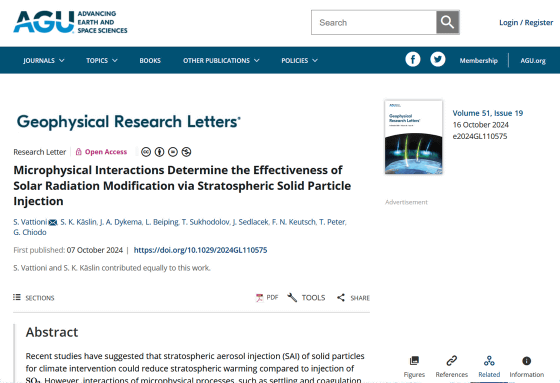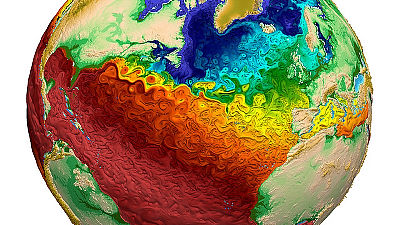It turns out that scattering diamond particles into the atmosphere can cool the Earth, but it would cost about 2.6 quadrillion yen

It has been pointed out that global warming not only increases the risk of heatstroke due to rising summer temperatures, but also brings about risks such as increased disasters, infectious diseases, and food shortages. In recent years, in addition to reducing greenhouse gas emissions, research has also been conducted on '
Microphysical Interactions Determine the Effectiveness of Solar Radiation Modification via Stratospheric Solid Particle Injection - Vattioni - 2024 - Geophysical Research Letters - Wiley Online Library
https://agupubs.onlinelibrary.wiley.com/doi/10.1029/2024GL110575

Are diamonds Earth's best friend? Gem dust could cool the planet | Science | AAAS
https://www.science.org/content/article/are-diamonds-earth-s-best-friend-gem-dust-could-cool-planet-and-cost-trillions
Could injecting diamond dust into the atmosphere help cool the planet?
https://phys.org/news/2024-10-diamond-atmosphere-cool-planet.html
Geoengineering is a term that refers to intervention in the climate system to deal with climate change, and methods that have been proposed so far include ' seeking iron in the ocean to increase the growth rate of algae and promote photosynthesis ' and ' deploying reflective membranes in space to block sunlight .'
Among them, the ' stratospheric aerosol injection ' method, which injects chemicals that reflect sunlight into the stratosphere, is inspired by the natural phenomenon in which sulfur dioxide released into the atmosphere by volcanic activity turns into sulfate aerosols in the stratosphere, which reflect some of the light from the sun. In fact, it was reported that the 1991 eruption of Mount Pinatubo in the Philippines created a layer of sulfate aerosols all over the Earth, causing a drop in temperature by 0.5 degrees for several years.
While stratospheric aerosol injection is a theoretically promising option, artificial release of sulfur dioxide also poses a number of climate risks. Sulfate aerosols contain sulfuric acid droplets, the main component of acid rain, and the aerosols can damage the ozone layer , affecting weather and climate patterns in the atmosphere.

So
The climate model developed by the research team also simulated how aerosols eventually fall to the ground (settling) and how they aggregate. The longer it takes for aerosols to sink from the atmosphere to the ground, the longer the cooling effect will last. Also, because aggregates tend to trap heat, the cooling effect will be greater if the individual particles do not aggregate as much as possible.
Using a supercomputer to evaluate the effects of each compound over a 45-year period, they found that diamond particles were the best at reflecting sunlight, and because diamonds are chemically inert, they are not thought to contribute to acid rain like sulfur dioxide.
According to Battioni and his colleagues, if 5 million tons of diamond particles were injected into the stratosphere every year, it would be possible to cool the Earth's temperature by 1.6 degrees. Of course, to inject this much diamond, a large amount of artificial diamonds would need to be produced every year, and it is estimated that injecting diamond particles into the stratosphere from 2035 to 2100 would cost about $175 trillion (about 2.6 quadrillion yen).

Of the seven compounds simulated in the study, sulfur, which has been deemed a promising option for stratospheric aerosol injection, was rated second-lowest because sulfur tends to absorb some wavelengths of light and trap heat, potentially offsetting some of the cooling effect and disrupting weather patterns.
Still, sulfur is widely available, cheap, and because it's a gas, it's easier to spray than solid particles like diamonds, making it a good candidate for stratospheric aerosol injection, argues Douglas McMartin, a climate scientist at Cornell University. 'I think it's interesting to explore these other materials,' McMartin said. 'But if you asked me today, 'What's going to be deployed in stratospheric aerosol injection?' the answer would be sulfates.'
Some scientists are concerned about the unintended consequences of geoengineering and oppose geoengineering research because it would divert scientists and funding away from more practical research such as reducing carbon emissions. Battioni said, 'Rejecting geoengineering research itself underestimates the scope of the problem we're dealing with,' and argued that geoengineering research is meaningful.
Related Posts:
in Science, Posted by log1h_ik







